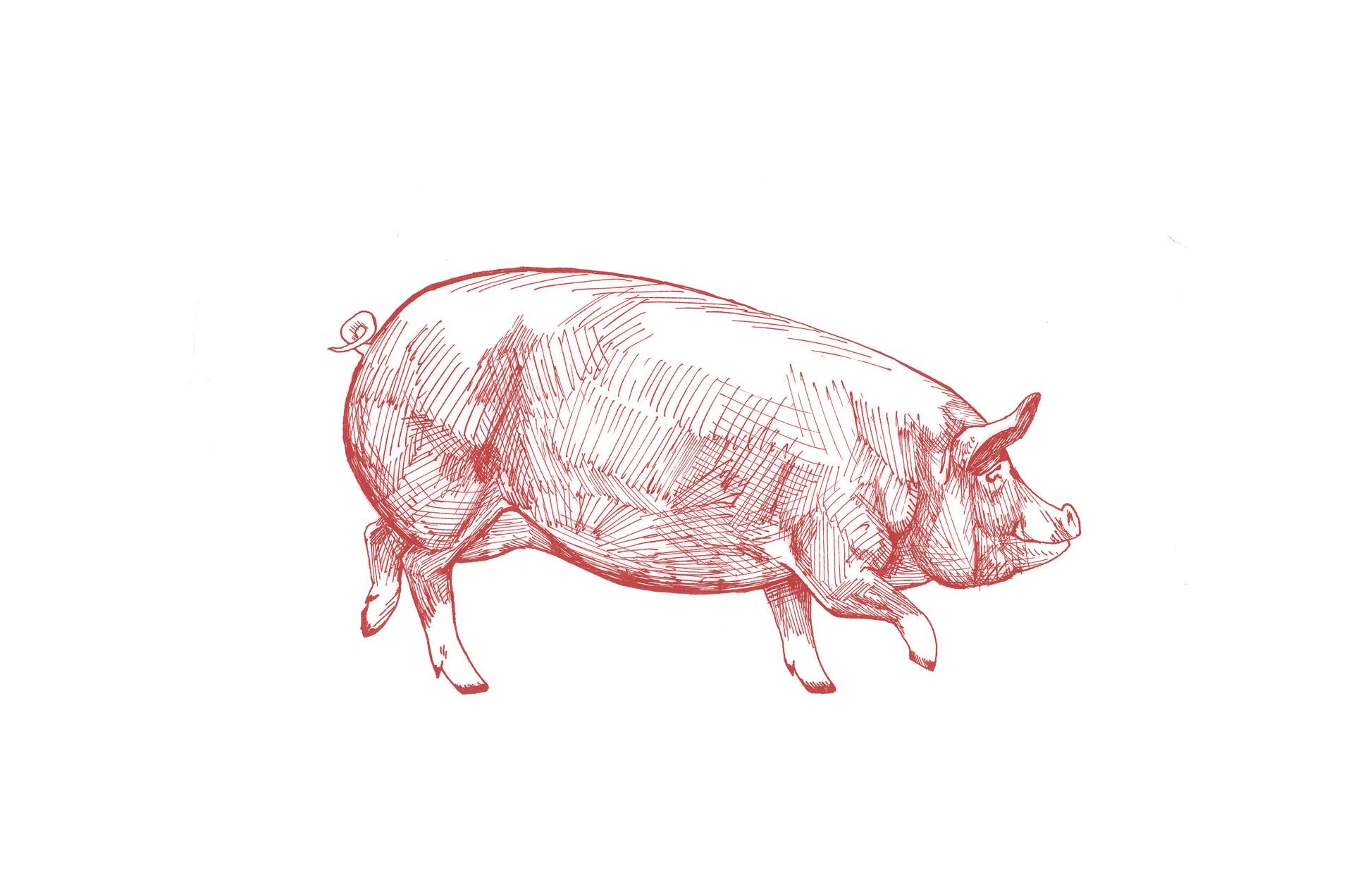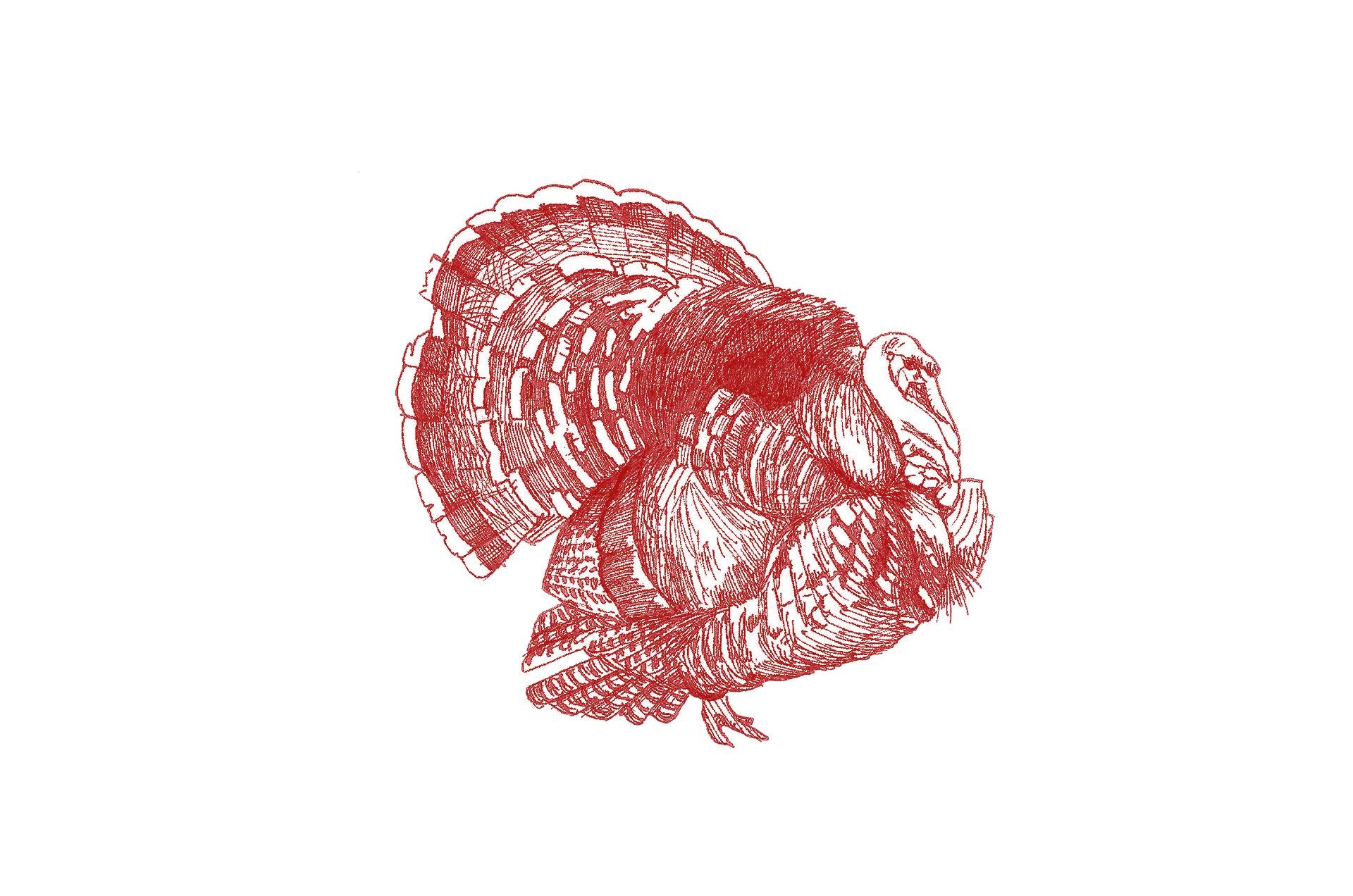The Red Wattle pig, with its signature wattles that hang from its jowl, can be traced to New Caledonia where it arrived thanks to traders from China. After centuries in the South Pacific, where farmers made breeding decisions to maintain the breed’s quality, it was discovered by the French who liked it so much they boarded it onto ships and took the pig to New Orleans. There the Wattle would come to anchor the great gastronomic traditions of Creole and Cajun cuisine, even when many other pork options were available. Later the breed ended up roaming the forests of east Texas, part wild, part domesticated. Rumors eventually spread of their possible extinction until a wild herd was discovered, recognized by their cinnamon color and wattles. Starting in 2005, chefs at America’s top restaurants started demanding the Red Wattle for their menus, more farmers started to raise the breed, and their population numbers started to increase. Click here to read more about the Red Wattle breed.
Threatened: Fewer than 1,000 annual registrations in the U.S.
Taste Notes: Sweet, nutty, floral, robust, concentrated, bold, tender, and porky, boasting a melt-in-your-mouth fat.
Producers: Lazy S. Farms, a consortium of 18 Amish families in Iowa, Nebraska, Missouri, and Kansas.
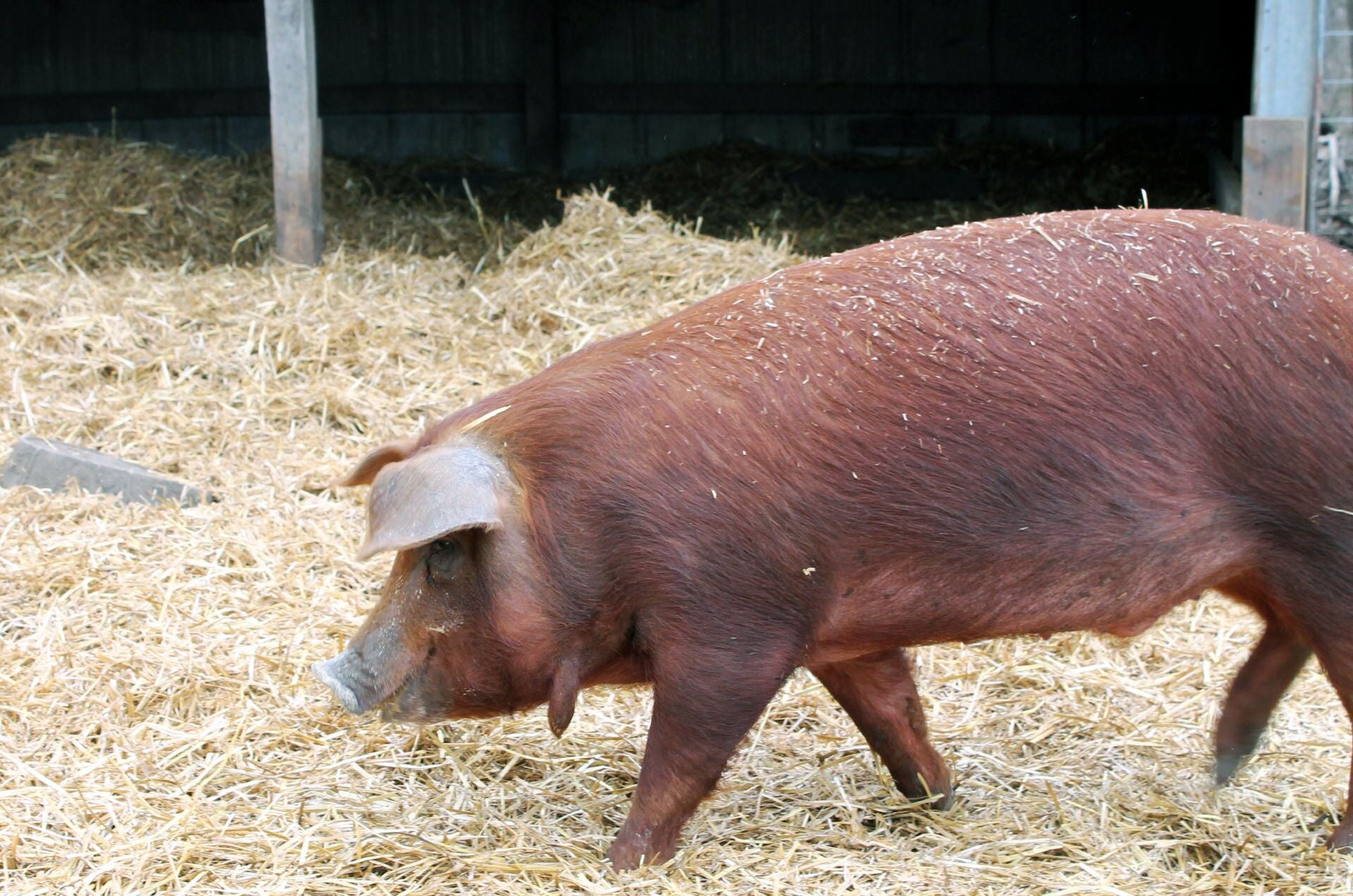
The Gloucestershire Old Spot is the aristocrat of the pig world. It’s never in a rush. How could it be with its large ears covering its eyes? It eats well and is famous for the plentiful amount of milky tasting backfat it develops over time. It is storied that the Old Spot is spotted because of fallen orchard fruit that would hit its body, then be eaten! The Old Spot is used to having plenty of attendants around and was once known as the Cottager's Pig, living closely to its human family, but also ranging in the yard or nearby woods. The Old Spot is a hearty self-reliant breed, a good mother, and used to living outdoors. The meat is delicious but especially prized by charcutiers who seek its plentiful back fat. Click here to read more about the Old Spot breed.
Threatened: Fewer than 1,000 annual registrations in the U.S.
Taste Notes: Milky, sweet, fatty, and tender.
Producers: Craig and Amy Good outside of Manhattan, Kansas
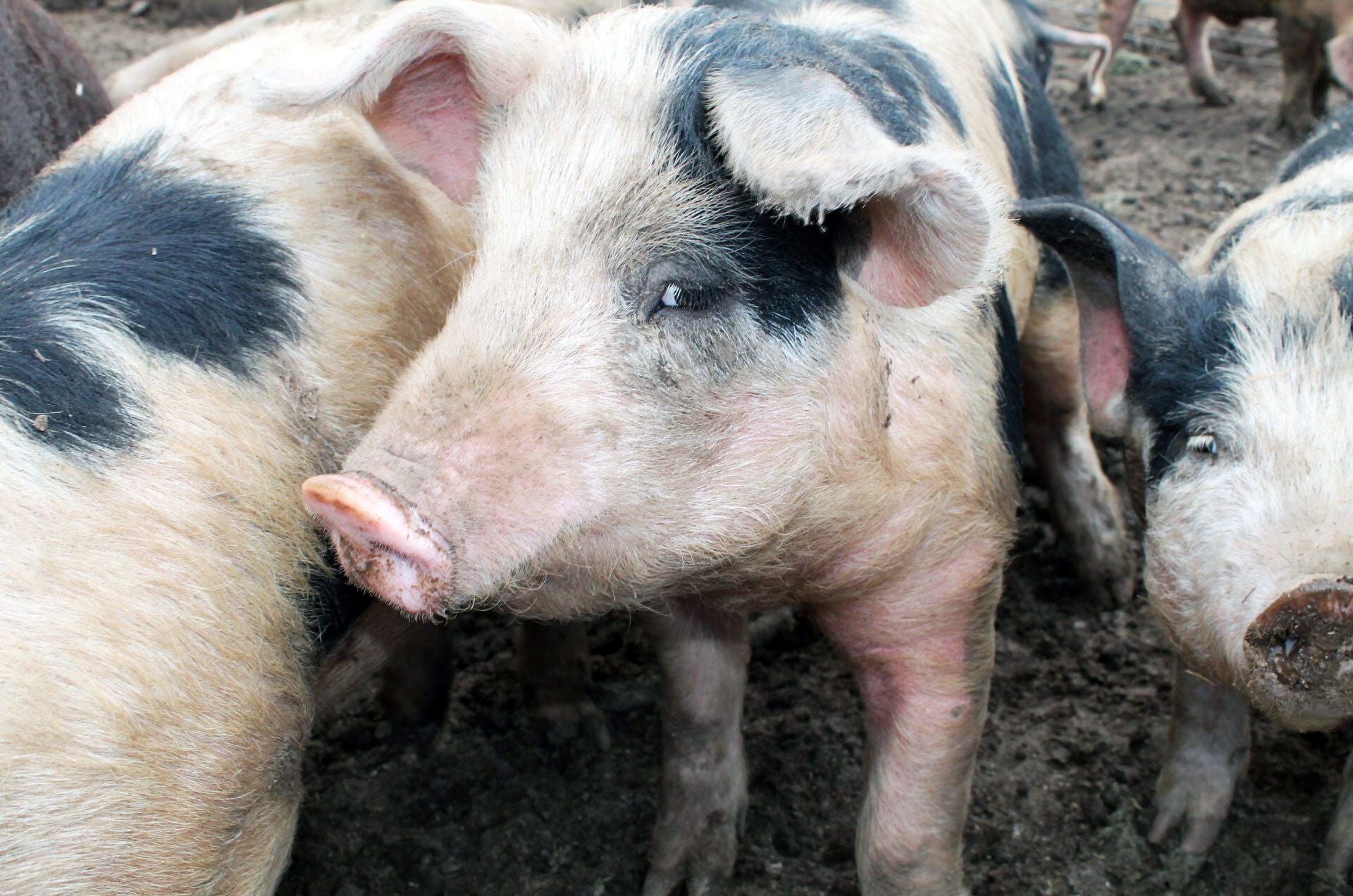
The Tamworth is a rare breed of pig that came to the Americas in the 1800s after centuries living in the forests of Ireland where they were known as Irish Grazers and in England where they foraged in woods of oak and beech. Over time the breed developed attributes that would enable it to function well in these challenging terrains. High legs and good athletic ability came in handy when navigating the undergrowth. Long faces and snouts were built to root and find food. Even the traditional Tamworth today remains high energy, alert, and sensitive to flight instincts, as if they are operating on a higher gear than other pigs. Considered “deep sided pigs,” Tamworths have been celebrated for centuries for producing delicious bacon.
Watch: Fewer than 2,5000 annual registrations in the U.S.
Taste Notes: Robust, fruity, sweet, and tender.
Producers: Craig and Amy Good outside of Manhattan, Kansas; Dustin and Maria Torneden of Lawrence, Kansas
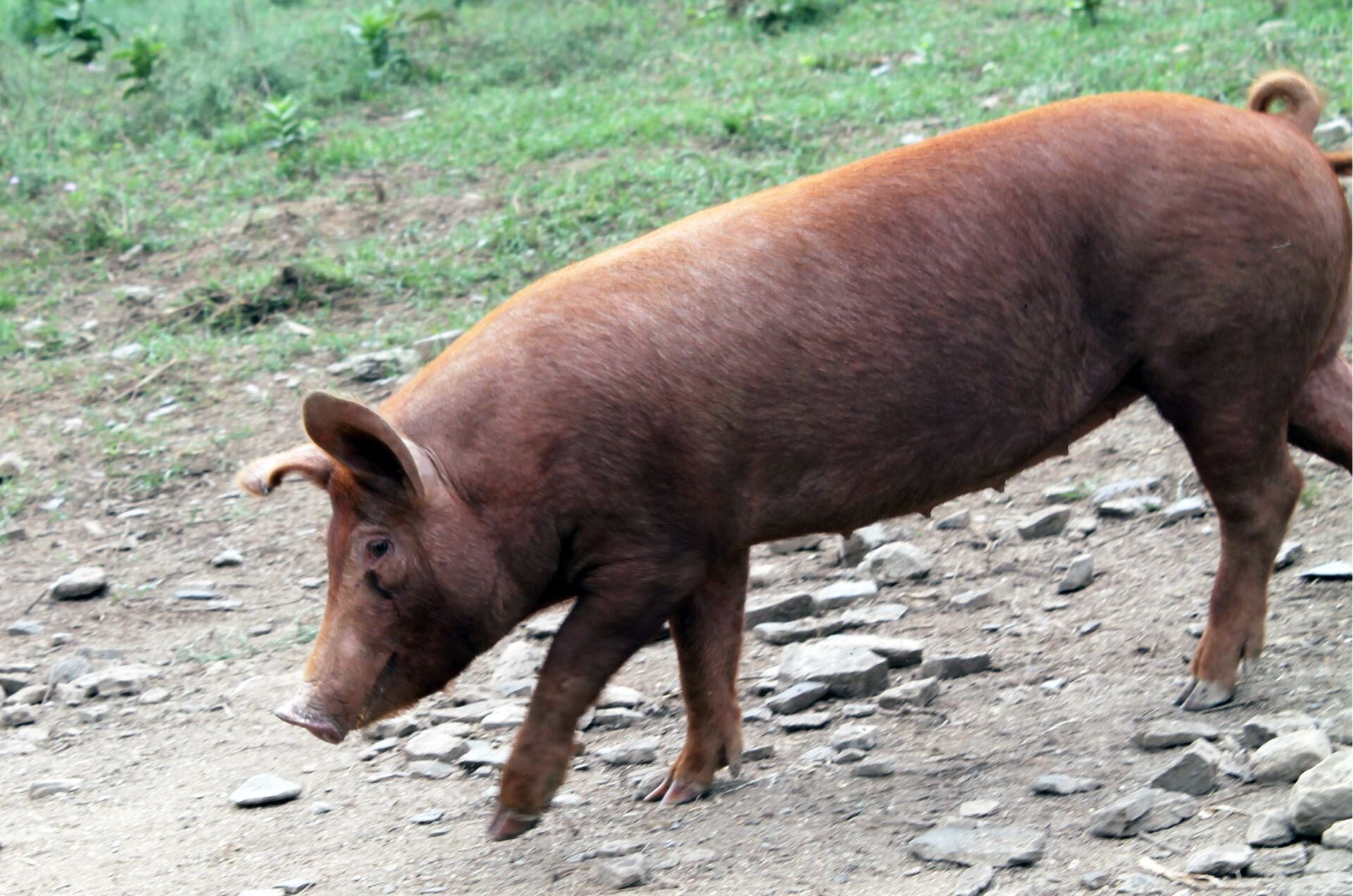
Something happened to the pig about 300 years ago on farms in the Berkshire region of England near London, something very special. Farmers made magic in those pens and paddocks. The story of the Berkshire is a story of breeding, breed maintenance, and breed improvement over centuries, beginning when the ancestor of today’s Berkshire was reportedly discovered by Oliver Cromwell’s army in winter quarters at Reading, the county seat in the shire of Berks. The Berkshire pig is still by far consistently the most decorated and award-winning pig for taste and flavor (followed by the Duroc). Over centuries, professional taste tests by novices and professionals alike have confirmed that meat quality on the Berkshire is unrivaled. Click here to read more about the Berkshire breed.
Taste Notes: Sweet, juicy, and tender with a great depth of flavor.
Producers: David and Kristin Newman and a consortium of family farms in Kansas, Missouri, and Iowa
Though the Duroc breed evolved from red pigs from another part of the world, it is considered one of the few “all American” breeds we have today. Unlike most breeds of livestock that were developed elsewhere and brought here, the Duroc is the result of two red colored breeds being crossed and then improved upon in the early 18th century in upstate New York. Where those two original red breeds came from is the subject of much debate as there are no pigs native to the Americas. Today the Duroc is in many ways the perfect pig boasting excellent meat quality. It is rugged and durable and has a great ability to efficiently convert pounds of feed into pounds of high quality meat. Durocs can range from a light golden almost yellow color to a dark mahogany.
Taste Notes: Clean and sweet; lean meat with a mild flavor.
Producers: Craig and Amy Good outside of Manhattan, Kansas; Dustin and Maria Torneden of Lawrence, Kansas

Threatened: Fewer than 1,000 annual registrations in the United States
Origin: 1860 Oregon territory by way of England
Flavor Profile: Olive, lavender, sweet, round
Producers: Tamarack Sheep Farm, Corinth, Vermont
History: The Dorset Horn is a breed of sheep that spread over Dorset, Somerset, Devon, and most of Wales during the 1700s. Once popular with English aristocracy, the Dorset Horn has seen a steady decrease in population since the inception of industrialized agriculture. Dorsets tolerate heat well— heat tolerance contributes to the rams’ ability to breed earlier in the season than rams of other breeds. The Dorset Horn is able to give birth three times a year, which contributes to the Dorsets profitability and appeal for farmers who are familiar with heritage breeds.

Watch: Fewer than 2,500 annual registrations in the United States
Origin: 18th Century Eastern United States by way of Tunisia, Libya and Egypt
Flavor Profile: Earthy, minerally, buttermilk, light, silky
Producers: Tamarack Sheep Farm, Corinth, Vermont
History: The Tunis breed originated in Tunisia and is reputed to be more than 3000 years old. Referred to as fat-tailed sheep in the Bible, the color ranges from tan to red with the occasional white spot on the head and haunches. John Adams mentioned the breed in his diary in 1782 noting its exceptional taste. Thomas Jefferson ordered a herd be imported from Tunisia because he loved them so much. George Washington bred them too.

Threatened: Fewer than 1,000 annual registrations in the United States
Origin: 1500s Navajo Country and the mountains of New Mexico by way of Spain
Flavor Profile: Rich, earthy, tangy, sweet, mustard seed, spicy, herbaceous, silky
Producers: Antonio Manzanares in the Navajo Country
History: The Churro was brought to the Americas in the 1500s by the Spanish. The earliest domesticated livestock in the New World, it quickly became integrated in native culture and cuisine. The Navajo-Churro produces excellent wool and meat. It was Navajo women who owned the sheep, the grazing rights and the wool, which was an important source of income. The Navajo-Churro existed in great numbers until the 1860s when the United States government targeted their populations while at war with the Navajo.
The turkeys we eat today originally came from Central America, were brought to Europe, domesticated there, then reimported back to the United States where they were crossed with wild turkeys. The descendants of these turkeys are the ones that would eventually be certified by the American Poultry Association as standard breed starting in 1873. The books the APA published each year since, called the Standards of Perfection, would become the template of what poultry production in America would be for the next 100 years, until industrial farming took over.
The flavor profile of heritage breed turkeys are almost identical because they all descended from the Bronze Turkey. Compared to industrial turkeys, Heritage turkeys have a flavor profile that is a deep, rich, dark turkey taste, with an aroma that will fill your house. Heritage turkeys are universally acclaimed to be the tastiest birds on the market today.
Watch: Fewer than 5,000 breeding birds in the US with 10 or fewer primary breeding flocks
Origin: Rhode Island
Producers: Frank Reese, Good Shepherd Ranch
History: The first standard bred turkey in America. Developed in the 1840s and first shown at the first American Poultry Association show in 1873 in Buffalo New York the Bronze became the foundation for all domestic turkeys in the United States. It is known for its shimmering, coppery, gold color.
Watch: Fewer than 5,000 breeding birds in the US with 10 or fewer primary breeding flocks
Origin: Rhode Island, United States
Producers: Frank Reese, Good Shepherd Ranch
History: A descendent of the Bronze turkey that was developed in the Narraganset Bay in Rhode Island in the 1850s and 1860s. Producers there liked the color pattern, a silver turkey with a golden tail, and selected for it. Driven by wagon to supply the New York market, this breed would become famous around the country.
Watch: Fewer than 5,000 breeding birds in the US with 10 or fewer primary breeding flocks
Origin: Bourbon County, Kentucky
Producers: Frank Reese, Good Shepherd Ranch
History: Around 1890, Mr. J.F. Barbee started selecting for a dark, red, mahogany feather pattern by crossing the Buff turkey with the Black turkey. Originally called the Chestnut Red, the breed remained relatively unknown but when the name was changed to Bourbon Red it greatly increased in popularity.

Threatened: Fewer than 1,000 breeding birds in the US with 7 or fewer primary breeding flocks
Origin: Ohio, United States
Producers: Frank Reese, Good Shepherd Ranch
History: A genetic mutation of the Bronze turkey that produced an all-white pattern in the feathers was given the name White Holland by the American Poultry Association in 1873. Originally made popular in Ohio, white feathers would become the way of the industry over 100 years later.

Threatened: Fewer than 1,000 breeding birds in the US with 7 or fewer primary breeding flocks
Origin: Maryland and Virginia
Producers: Frank Reese, Good Shepherd Ranch
History: The Native Americans throughout Mexico and Central America highly prized Black turkeys. The turkeys brought back to Europe by Christopher Columbus were Black turkeys and some people still call them “Spanish Black”.
Watch: Fewer than 5,000 breeding birds in the US with 10 or fewer primary breeding flocks
Origin: New Hampshire and Eastern United States
Producers: Frank Reese, Good Shepherd Ranch
History: Red Feathered chickens were a desired trait and farmers started to select for them in the 18th Century. It was not until the early 20th Century that this breed was distinguished from the Rhode Island Reds. New Hampshires are renowned as a dual-purpose chicken, excellent egg layers and meat producers.
Threatened: A 100% authentic historic Barred Rock are almost impossible to find
Origin: New York State
Producers: Frank Reese, Good Shepherd Ranch
History: The Barred Rock is the foundation of the poultry industry and was raised by the millions from 1870 -1950. They remained king of the industry until they were replaced by the industrial Cornish. They say the original Barred Rock has never been beat in a tasting contest. As an animal it is hearty, tough and reliable as well as beautiful to look at.
Watch: Fewer than 5,000 breeding birds in the US with 10 or fewer primary breeding flocks
Origin: New Jersey
Producers: Frank Reese, Good Shepherd Ranch
History: In the 1890’s the Black Brothers bred for a very large roasting chicken for the New York market. The Jersey Giant was created as a replacement for turkey that easily fit into a New York City oven. It is still the largest of all domesticated chickens.

Threatened: Fewer than 1,000 breeding birds in the US with 7 or fewer primary breeding flocks
Producers: Frank Reese, Good Shepherd Ranch
History: The history of the slow growing Cornish game is ancient and it was originally known as the Old English Game hen. The Cornish Hen was originally developed at least 1000 years ago as a fighting bird, which is where they got their names as “gaming” chickens. They were eventually given the name Cornish because they were the preferred breed in Cornwall, England, where they were loved by royalty.

Threatened: A 100% authentic historic Columbia Wyndotte is almost impossible to find
Origin: New York
Producers: Frank Reese, Good Shepherd Ranch
History: Developed to live in upstate New York and in cold climates, this bird is known for its great amount of yellow fat, prized by chefs for its flavor. While there are Wyndottes that can be traced back 100s of years, the American Wyndotte was accepted into the American Poultry Association in the 1890’s. The breed comes in different colors including silver laced, white, and black.

Threatened: Fewer than 1,000 breeding birds in the US with 7 or fewer primary breeding flocks
Origin: Rhode Island
Producers: Frank Reese, Good Shepherd Ranch
History: Part of the movement to improve the quality of birds from 1910-1930, the Rhode Island White was originally developed to be raised as a hearty dual production bird in the cold climates like Maine and Vermont. They have small combs and small wattles making them less susceptible to frost bite. A very unique breed, they were recognized as a pure breed in the 1920’s.
Watch: Fewer than 5,000 breeding birds in the US with 10 or fewer primary breeding flocks
Producers: Frank Reese, Good Shepherd Ranch
History: The Delaware is a cross between the New Hampshire and Barred Rock chickens resulting in a “Delaware pattern” which is a white feathered bird with black barring on the tail, neck, and flight feathers. The Delaware was created because farmers wanted a white feathered bird for the market that was also delicious: New Hampshires and Barred Rocks were the meat kings of the time.
Critical: Fewer than 500 breeding birds in the US with 5 or fewer primary breeding flocks
Origin: Aylesbury, England
Flavor Profile: A bouncy texture and rich creamy fat, robust flavor with nutty and herbaceous notes
Producers: Frank Reese, Good Shepherd Ranch
History: The Aylesbury Duck reached its peak popularity in the late 1800s when thousands of ducklings were sent from the town of Aylesbury to London and served at the top restaurants of the day. Since then, the breed was crossed with other breeds like the Pekin, which fared better in industrial settings. If it were not for a few dedicated farmers who kept it pure, it is likely the breed would have disappeared for good. This is the original Christmas duck.
Watch: Fewer than 5,000 breeding birds in the US with 10 or fewer primary breeding flocks
Origin: Toulouse, France
Producers: Frank Reese, Good Shepherd Ranch
History: The original Foie gras goose, this was the goose of wealth and royalty, praised for the large amount of meat and delicious fats they produced. It has a grey back, grey neck a bright orange bill with a pure white underbelly. Known for its extra large size and heavy feathers it also has a Dewlap, a pendulous skin appendage that develops under the throat of the goose — very unique trait to the Toulouse.
Recovering: Breeds that were once listed in another category and have exceeded watch category numbers
Origin: 1900s imported to the Unites States from Bern, Freiburg, Glarus, and Graubunden in Switzerland
Producers: Joseph Hubbard, Shannon Creek Farm, Kansas
History: These breeds originated in the mountains and hills of the Swiss Alps. Their color pattern is called chamoisee and the breed is well known internationally and is numerous in Switzerland. A breed association for the Oberhasli was formed in 1977 and they are a proud member of the American Dairy Goat Association.
Origin: 1987 imported to the United States by way of South Africa
Producers: Luce Guanzini and Mark Baustian of Highwood Farm, New York, and Jim and Jean Bright, Bright Farm, New York
History: The development of the Boer goats came about when European imports were cross bred with “indigenous” stock in South Africa. The product of this cross breeding produced short haired goats with light red heads that were hardy, adaptable animals that produced a delicious meat.
Origins: 1950s imported to the United States by way of France
Producers: Luce Guanzini and Mark Baustian of Highwood Farm, New York, and Jim and Jean Bright, Bright Farm, New York
History: Color pattern is not the defining trait for Alpine goats, instead they have been breed with a focus on their size and production. They are a larger breed and are excellent milk producers. The breed originated in the Alps and they are hardy, adaptable animals.
When it comes to beef, our palate and our heart lies with one breed that has come to be our source for over a decade! Akaushi beef is near and dear to us because the taste is so consistently juicy, buttery, and delicious.
Only a limited amount of Wagyu derives from the Akaushi breed, also known as the Emperor's breed in Japan, where it was first free ranged on Mount Aso, the largest active volcano in Japan.
The particular marbling of the Akaushi means every bite is consistently juicy, buttery, and melts in your mouth. Our Signature Line has savory earthy notes of mushroom and olive. Our Premier Line is more buttery and tender. Salt and pepper is all this meat needs to stand out as one of the best meals you will ever eat.
Akaushi beef has a higher concentration of monounsaturated fat which the American Heart Association notes can lead to lower cholesterol and is a natural source of oleic acid which gives it a buttery taste.
The Japanese Association of Akaushi was founded in 1944 with the goal of researching breeding techniques to produce the best tasting beef in the world. This data has been used in the selection of every Akaushi dam and sire over the last half-century. Hard work, coupled with the discerning palates of Japanese consumers, has led the Association to accomplish its mission! In the United States, the Beeman Family and their HeartBrand Ranch are our source for our Signature and Premier lines of Akaushi Wagyu!
We have partnered with Slow Food to promote their Ark of Taste project, an international catalog of endangered foods. We are proud to feature a selection of these products for sale year round.
